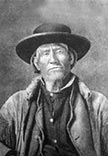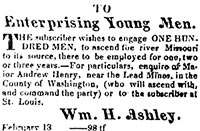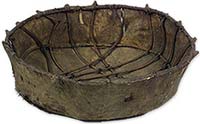Jim Bridger ~ Index

Jim Bridger's connection with the discovery of Cache Valley in 1824.
Jim Bridger was born in Richmond, Virginia, March 17th, 1804. He was left motherless at the age of twelve and completely orphaned at the age of thirteen by the death of his father, who was a surveyor. He purchased a flatboat and piloted it up and down the Missouri River near which place the family had removed. The work was too heavy and thereafter he was apprenticed to a blacksmith in St. Louis by his aunt. In this shop he worked for five years and his schooling was sadly neglected. Here was where he began to hammer his character into the hardships that he was to endure later.
March 20th, 1822, there was a want advertisement appeared in the St. Louis Republican newspaper for, One-hundred hardy enterprising young men to ascend the Missouri River to its source and there to be employed for two or three years.
For particulars, the applicants were to see Major Andrew Henry and William H. Ashley. Many of this group later became famous as explorers and trappers but none became more so that the illustrious eighteen-year-old blacksmith, James Bridger. At that time Bridger's desire was to save some money for his sister who was in a Catholic school.

The Rocky Mountain Fur Company was organized on April 15th, 1823 and under the command of Major Andrew Henry, the party started with supplies for trapping and trading with the Indians for three years. One large keelboat was snagged and sunk just below old Fort Osage, on the Missouri and about $10,000.00 worth of supplies were lost. The party continued on its journey.
After passing the Mandan villages (in Bismarck, North Dakota) a band of Assiniboines Indians outwitted the trappers and took the entire herd of horses. The trappers were forced into winter quarters at the mouth of the Yellowstone River in the winter of 1822–1823. Major Henry secured a new supply of horses from the different Indian tribes and his men explored and trapped. Bridger was plunged into the real wilderness life that was to hold him captivated for forty years. The company in the spring of 1823 moved up the Missouri toward the Great Falls but encountered the Blackfeet Indians and had a battle. Four trappers were killed and the company was forced out of this section of the country. This was a real experience for the young Bridger.

Later in the summer of that year, a courier from Ashley called the company back to the lower Missouri to assist another company of trappers and some troops whose progress was being hindered by the Arickara Indians. This gave Bridger his first experience with government troops and to act as a guide or scout. Later in life he spent much of his time aiding army officers in Indian campaigns.
Ashley, after being rid of the Arickaras' ordered Major Henry and eighty picked men, including Bridger, to go back to the mountains on their original errand. They reached the mouth of the Yellowstone River after a number of skirmishes with the Indians on the way and lost two trappers. They also lost twenty-two of their precious horses, but they moved on to the mouth of the Powder River, in eastern Montana on the Yellowstone River and wintered 1823-1824.
In the spring of 1824, Major Henry divided his forces in order to cover the beaver streams to better advantage. Etienne Provost headed the party which went up the Big Horn River and went into the basin of the Wind River, Wyoming. Bridger was with this group. The group found itself on the Continental Divide at the head of the Green River just southeast of the Yellowstone Park and not far from Jackson Lake. Here they found the South Pass down the Green River. At a point down the Green River not far from the fort that was later called Fort Bridger, Provost divided his men and put Bridger in charge of the party to go west to the Bear River. The party went down the Bear River and explored the side streams and made particular stops at Soda Springs. They followed the river around by Alexander and stopped where Grace now is. They continued down the course of the river through the Oneida Narrows and into Cache Valley, then called Willow Valley.

This valley became an important rendezvous and resort for fur traders. In this valley they went into winter quarters 1824-1825. The exact spot is not known, but it is believed the party camped about where Cache Junction is located.
There was much conjecture among the party as to the outlet of the Bear River. This was particularly the cause with young Bridger as he was curious and was always seeking adventure. Impelled by his own desire and by a wager as a goal or excuse, he rode the Bear River in a rawhide boat through the Bear River Canyon and was perhaps the first one to sight Great Salt Lake. At first he tasted the water and finding that it was salty, he thought he was in the arm of the ocean. Robert Campbell, who was in the Bridger party, claimed that Jim Bridger was the first to reach the lake. The party joined the Provot party, which came down the Weber River and trapped on the way.
Notes…
The Jim Bridger marker text (above) reads: No. 10, Erected 1932. In Honor of James Bridger, 1804-1881. Early western fur trapper, frontiersman, scout and guide. To settle a wager among the trappers who were making their first winter rendezvous in Cache Valley, Bridger floated alone in a bull boat down Bear River to its outlet to determine the river's course in the late autumn or early winter of 1824. Thus making the original discovery of Great Salt Lake, but believing he had discovered a salty arm of the Pacific Ocean, he halted at such viewpoints as as this en route to reconnoitre. Bear River Chapter of Future Farmers of America and Utah Pioneer Trails and Landmarks Association.
The advertisement (above) for Enterprising Young Men
is from the Missouri Gazette, February 13th 1822.